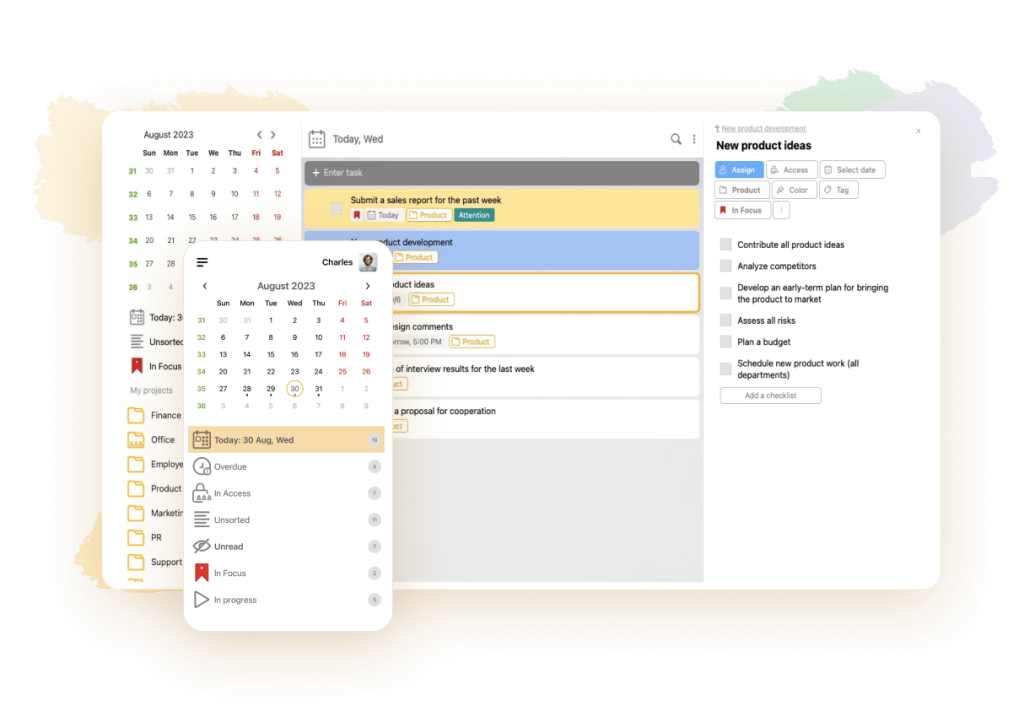Assessing Employee Performance

The success and stability of any company is influenced by the efficiency of its employees. Some of them actually work out their salaries, while others only give the appearance of active work, being engaged in personal affairs. To determine how the actions of each employee affect the productivity of the company, the assessment of personnel efficiency helps. It shows to what extent an employee corresponds to the position he holds, and to what extent his salary level corresponds to his contribution to the company’s development.
Why evaluate staff performance
According to statistics, 70% of company employees are constantly distracted from the work process. Using messengers, social networks, calling home during working hours – all this prevents them from concentrating on their main duties. And only 40% of employees understand the essence of the tasks assigned to them by their managers. Because of this, companies lose 20 to 30% of their revenue every year.
To avoid losses due to irrational use of labor resources, personnel performance evaluation is applied. This is a system of criteria determining how well a person corresponds to the position he holds and how he copes with the assigned work. Studying the productivity of employees is useful not only for managers, but also for the performers themselves.

The study takes into account:
- the amount of work performed by the employee;
- complexity;
- compliance of the performed tasks with the job responsibilities;
- the results of the work and the time spent on it.
- resources expended.
Employee evaluations accomplish the following objectives:
- Determine the skills, abilities, and professional level of performers.
- Make the right personnel changes.
- Improve the KPI and motivation system in place in the company.
- Eliminate chaos and clutter in the workforce.
Based on the results of the assessment, many strategic decisions can be made that have potential benefits for the company. For example:
- Build an employee promotion matrix.
- Develop a checklist system based on the real level of staff knowledge.
- Draw up a plan for training and professional development of employees. Conclude agreements with training organizations.
- Identify leadership candidates who can develop from line workers into competent managers.
- Analyze work processes, identify weaknesses in the company’s business strategy.
It is necessary to conduct a preliminary personnel assessment at the hiring stage. This will help to determine the future composition of the work team by establishing a minimum list of requirements for applicants. Once an employee has been hired by the company, he is regularly checked for compliance with the position held.
Personnel performance evaluation is necessary if the company is experiencing a constant outflow of personnel, decreasing labor productivity. Or when employees complain about poor working conditions, disrespectful attitude, low wages.
Staff appraisals are performed in the following cases:
- In workforce planning.
- When recruiting company personnel.
- When organizing trainings, training for managers.
- To build a talent pool.
The analysis of indicators characterizing the efficiency of personnel utilization allows the company to hire people with the right qualification level, knowledge and abilities. This allows the company to significantly reduce the cost of services of intermediaries engaged in personnel recruitment, reduce the number of interviews in the company.
Increase the efficiency of each employee can be improved at:
- A mutual willingness to work. In order for each team member to work with full dedication, the manager should outline the prospect of possible growth and rewards in the form of bonuses or bonuses. This will have a positive effect on both sides. The employee will improve his well-being and the organization will gain additional profits due to rational use of labor resources.
- Turning a subordinate’s personal self-interest into a tool for increasing his effectiveness. Recognizing a particular person’s interest can be used as motivation.
- The manager’s interest in the success of the staff. If team members feel “important” and useful to the company, they will do their best to justify the trust placed in them.
- Creating a comfortable workplace environment.
It is necessary to assess the competence and quality of personnel work on a regular basis. Every business representative realizes this. But how can this be done correctly? After all, a person can quite cope with his duties, but at the same time constantly distract his colleagues, asking for their help. Or not meet the deadlines. For this reason, the efficiency of each employee is determined on the basis of many indicators, including labor costs and time spent on work. In Japan, for example, this indicator is determined on the basis of each employee’s abilities.
Based on the assessment of personnel performance, they develop a system of bonuses and rewards. They make decisions on their transfer to new positions or dismissal.
Personnel performance evaluation criteria
In order to properly evaluate the efficiency of an employee, it is necessary to consider his working, personal, and behavioral characteristics. For this purpose, performance evaluation criteria are used to determine how each function should be performed. The criteria are developed by company managers together with representatives of the HR management service or together with subordinates.
The joint development of evaluation criteria has a lot of positive aspects for the company. They will be understood by the management staff and performers. They will not cause rejection among the performers. They will be based on the peculiarities of each specific work process.
In terms of coverage, the way of evaluation, the criteria are divided into:
- Organization-wide and specialized.
- Quantitative (results achieved are evaluated) or qualitative (individual qualities of an employee and the quality of work performed by him are taken into account).
- Objective (standards approved for each work process) or subjective (formed on the basis of expert opinions).
- Integral or simple.
The development of evaluation criteria begins with the identification of a list of positions. The functional responsibilities of the selected groups are then defined. The possibility of applying the criteria for each specific case is analyzed. The amount of information about the object of research is taken into account, the importance of each criterion applied in personnel assessment is specified.
Competency assessment
Examines the professional, personal qualities and knowledge of employees. This category includes:
- Professional skills. Evaluated on the basis of tests, examinations, compliance with industry-approved standards.
- Communication skills. Help determine an employee’s place in the team. Leader or outsider? Conflicted or loyal to colleagues? You can get this and other information about an employee from psychological tests and interviews conducted by the HR department.
Competency assessment also includes job performance, attitude, work ethic and company loyalty.
Staff performance
The performance of each employee is compared with the indicators planned for his position. Before an employee’s performance is evaluated, he is assigned specific tasks. Performance is measured in the volume of sales per month. It can also be displayed in the number of realized projects or concluded deals for the reporting period.
KPI or Key Performance Indicators are expressed as a percentage:
- of sales to the number of calls handled;
- the number of repeated requests of clients to the total number of clients in the database;
- results to resources expended.
To assess performance using the KPI method, a table divided into two columns is used. In one of them write down the evaluation criteria (quantitative or qualitative, individual or team). The second column contains the competencies approved for the position. The head of the unit assigns numerical values of 0 or 1 to the selected indicators, based on his own observations. The numerical values in each row of the table must be equal to one.
The effectiveness of KPI indicators has three levels:
- Baseline (the starting point from which the result is counted).
- Normal (binding under all conditions).
- Target or ideal (to which all employees should strive).
KPI indicators are assessed at the end of the reporting period. Qualitative values are assessed on a 100-point scale. Quantitative values are measured using the metric system. To determine the private result of an employee, the formula is applied:
(Actual data minus base KPI /Norm minus base) × 100% = percent result.
The data obtained shows the extent to which the employee has met or exceeded his target. If the KPI is above 100%, the employee’s performance is high. If this parameter is below 100%, it indicates that the staff is working inefficiently.
Each organization develops its own evaluation criteria, taking into account its specifics.

Methods of personnel performance evaluation
Various methods are used to determine the performance of a company’s employees. According to the direction, method of evaluation they are:
Qualitative. Otherwise known as descriptive. This includes:
- Matrix method. The characteristics of the performer are compared with the reference model corresponding to his position.
- Assessment of task performance. It implies answering the question, how is the employee doing his job?
- The method of system of arbitrary characteristics. Otherwise it is called the method of extremes. A manager or a representative of the personnel service makes a list of achievements and failures of an employee, and draws conclusions about his professional suitability.
- “360 degrees”. The employee’s performance is assessed by his colleagues, immediate supervisor and the subordinate himself. Information about the subordinate is collected by means of a questionnaire consisting of questions divided into separate blocks related to the employee’s activities.
- Group discussion. It is conducted in the form of direct discussion of the employee’s labor results with the management and invited experts. Using this method, it is possible to visually assess the employee’s stress resistance, communication skills with staff and management. Both parties can ask questions during the discussion.
Quantitative. Expressed in numbers. They give a more objective idea of the usefulness of each member of the work team. They include:
- Scoring method. An employee receives points for work performed on a 10- or 5-point scale. At the end of the reporting period (month, quarter or year) they are added together and analyzed.
- Free point evaluation method. Qualifications, skills and characteristics of an employee are evaluated by an expert committee. Based on their sum, a final rating is compiled.
- Ranking method. A committee of department heads is created to make a kind of ranking of employees based on their performance and usefulness. After comparing data from different sources, employees at the bottom of the list are dismissed or transferred to lower-paid positions.
Combined. Combine quantitative and qualitative methods. They give the most complete and objective assessment of employee performance. These are:
- Sum-of-evaluations method. All characteristics of an employee are evaluated on a set scale. On the basis of the data obtained, an average indicator is derived and compared with the benchmark accepted for this position.
- Grouping system. Depending on performance, employees are grouped into common groups consisting of leaders, “middlers” and outsiders. Then decisions are made as to who should be dismissed or moved to the top group.
The listed technologies provide an incomplete assessment of personnel performance or their socio-psychological qualities. Therefore, comprehensive methods based on a combination of all assessment approaches have recently gained popularity.
Methods of competence assessment
These methods of analysis are used for in-depth study of professional qualities of employees in order to effectively utilize the company’s human resources potential. On their basis they calculate ways to increase labor productivity at the enterprise, develop measures to reduce expenditures on wages of incompetent employees. These methods include:
- Attestation. Includes assessment of qualification, practical and theoretical skills of the employee. Analysis of his labor results, personal and professional characteristics. Conducted on the basis of standards approved for each position and specialty, according to a pre-approved plan with a frequency of three, two or once a year. The head of the company has the right to certify all employees, except for top managers, employees with less than one year of service or pregnant employees.
- Assessment center or assessment center. It consists of three stages: preparation, scenario development and the assessment procedure itself, consisting of business games, group discussions, interviews and tests. Application of this method gives an objective picture of the compliance of the staff with the goals, structure and policy of the company. Due to the complexity of implementation, this methodology is used mainly in large companies.
- Testing. It is based on professional and psychological tests. It helps to identify the employee’s level of knowledge, their suitability for the position held, as well as their personal characteristics.
- Interview. A series of questions to be answered by the employee. It can be conducted in a free or structured form. The maximum effect is given by the structural-behavioral interview, which invites the candidate to simulate a certain situation that arose in his professional activity, find a way out of it and evaluate his role.
- Expert assessment. Professional and personal qualities of employees are assessed by the company’s own or hired specialists.
- Business games. A model of a real business situation is created. In the course of the game the employee shows his professional and personal qualities, demonstrates his ability to work in a team. Demonstrates stress resistance, ability to react quickly to changes in the working situation.
When applying these methods to evaluate staff performance, it is important that they are objective and easy to understand.
Application of the LeaderTask for personnel efficiency assessment

Assessing the activities and performance of a company’s employees is a complex process that requires a lot of time and patience on the part of management. To make the personnel’s work successful, it is important to set clear and achievable goals for the employees. It is important to control the fulfillment of tasks and give appropriate assessment of the actions of the performer.
A reliable assistant in organizing the working time of staff will be specialized programs designed to systematize and promptly solve any tasks.
The key to successful work of any team is rational distribution of tasks to competent employees. In order to achieve efficiency from employees it is necessary to:
- assign them work that is commensurate with their professional skills, abilities and experience;
- give executors the authority appropriate to their rank;
- assign a leader to each group.
The usefulness and performance of employees should be monitored. It is more convenient to do it with LeaderTask tools:
- a convenient system for setting and controlling tasks. Adding a task to the system, assigning a responsible person, setting a deadline for its fulfillment are performed in a few clicks.
- Visual display of personnel efficiency. The manager can see the results of each employee’s performance on a graph or in statistical reports and draw appropriate conclusions.
- Prioritization of tasks. Important tasks are given a special status. This allows you to avoid being distracted by non-essential tasks and to do your work more productively.
The application’s functionality includes such options as: an assignment execution control program, an organizer, a task scheduler for iPhone and other devices. Using the program, you can avoid loss of important information and waste of time in key business processes, make the process of execution of orders clear and accessible to all employees.
Conclusion
The function of the HR department and company management is not limited to assessing the performance of employees, identifying “problem areas” and dismissing incompetent specialists. It is possible to get a positive result from the work of subordinates by offering them transparent and mutually beneficial cooperation in return. Personnel performance evaluation should be a constructive dialog that benefits both parties.
The results of the study are formalized in the form of reports or tables that contain detailed information about the employee. Based on them, the management makes a decision on his further employment with the company.
There are many techniques for studying performance. They have both positive sides and disadvantages. Therefore, when choosing a research method, it is important to take into account such factors as the structure of the company’s personnel, the specifics of its activities, and relations between employees.



